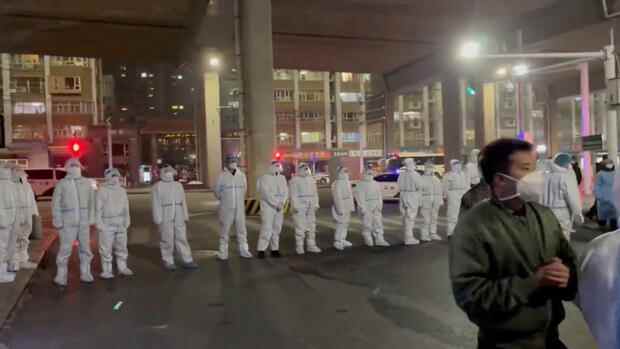In the capital of Xinjiang province, people protested against the tough corona measures.
(Photo: Video Obtained via REUTERS)
Shanghai/Beijing/Berlin In China, protests against the strict corona measures are spreading. On Saturday evening, people also took to the streets in the financial metropolis of Shanghai to vent their displeasure. First it was a vigil for the ten people who died in a high-rise fire in Urumqi. But over the course of the night, this turned into protests.
The crowd held up white sheets of paper as a sign against censorship. According to eyewitnesses and video footage, one group shouted, “Down with the Chinese Communist Party, down with Xi Jinping.” Public protests against the government and President Xi are rare in China.
As the AFP news agency reports, the protests also spread to Beijing on Sunday. Hundreds of students took part in a demonstration against the strict Covid restrictions at elite Tsinghua University, a witness told the news agency. Footage on social media showed the protests.
China is pursuing a zero-Covid policy, which entails far-reaching lockdown measures. The rise in the number of infections makes it less likely that China will ease its strict policy any time soon.
Top jobs of the day
Find the best jobs now and
be notified by email.
On Sunday, the authorities reported almost 40,000 new infections. However, the lockdowns and the global economic slowdown are slowing down the second largest economy in the world.
Many people are less and less willing to bow to the measures, and unrest breaks out. In Urumqi, capital of western China’s Xinjiang region, there were protests on Friday.
The authorities have again imposed numerous restrictions due to rising Covid numbers.
(Photo: Getty Images)
One of the longest lockdowns was imposed there: Many of the four million inhabitants are not allowed to leave their homes for up to 100 days. A fire in a high-rise building killed ten people on Thursday.
vigils at universities
The view spread on social networks that the building was partially locked and that many residents therefore did not make it out in time. Vigils were also held in other cities, including the universities of Nanjing and Beijing.
Videos in Shanghai showed people shouting “serve the people” or “we want freedom”. In the spring, the city with its 25 million inhabitants was strictly sealed off for two months. At that time there had already been rare protests.
Longtime China observer and Dutch correspondent Eva Rammeloo, who covered the protests in Shanghai, wrote on Twitter: “I’ve never seen anything like it in the decade I’ve been covering China.”
Also on Sunday, dozens of people went to Wulumuqi (Urumqi) Street in Shanghai to lay flowers for the ten people who died in the Xinjiang fire. Videos from eyewitnesses show small gatherings of people facing numerous police officers. Squares and streets were cordoned off, police cars drove through the streets.
The protests had initially broken up early on Sunday morning local time, the police reportedly arrested several protesters, others left the site voluntarily. Across China, people shared videos of the protests on Sunday night – they show how desperate people are. “Where is our future?” lamented a tearful young man in Shanghai, who faced motionless uniformed police officers.
As sports expert Mark Dreyer reports, Chinese state television has now stopped showing footage of the audience during the broadcast of the World Cup games from Qatar. Instead, close-ups of players are shown.
The reason: Due to the tight censorship in the Chinese media, many Chinese only realized through the recordings of the World Cup that masks were no longer compulsory in the rest of the world and that people had learned to live with Corona. That, too, had fueled the resentment.
With material from Reuters.
More: New lockdowns are squeezing China’s growth and weighing on European companies
